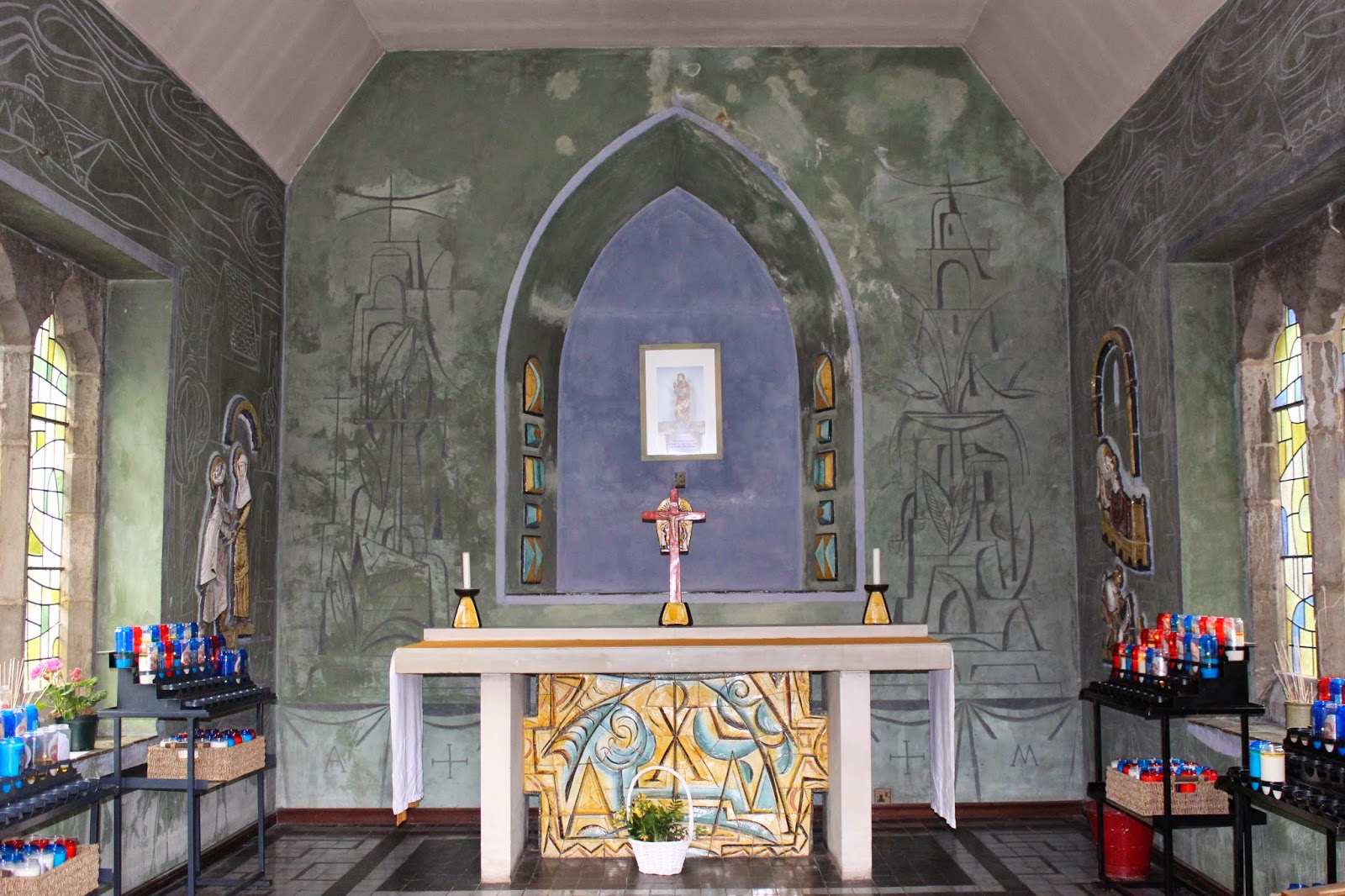
When Adam Kossowski was "deep in calamity" as a prisoner of war during the Second World War - "nearly dead" in a Russian labour camp - he made a promise to himself that if he came out of that "subhuman land" he would tender his thanks to God.
On arrival in Britain Kent
Kossowski was within his
comfort zone when his first commission was to paint the scenes from the history
of the Aylesford Carmelites which continue to adorn the walls of the Chapter
House at Aylesford. He was well outside that zone, however, when Fr. Malachy asked him to
create a series of ceramic scenes for a Rosary Way
This work was to shape not
only Kossowski's future commissions at Aylesford (where, from 1950 to 1972, he
decorated most of the shrine's chapels) but also the commissions he received to
decorate other Roman Catholic Churches. In both instances these commissions
were primarily, but not exclusively, for ceramic bas-reliefs. Working in clay
enabled Kossowski to create with a greater sense of 3D animation as well as the
expressiveness he was able to achieve by marking or cutting into the clay. As
each panel was also painted, these effects were combined with all the
variation, shade and harmonies achievable through paint.
Kossowski's obligation to God,
the ongoing support of a committed patron in Fr. Malachy and the post-war
church rebuilding programme combined to create the opportunity for Kossowski to
become one of the greatest and most prolific religious artists in twentieth
century Britain; a surprising result for the boy from Nowy Sacz in Poland.
Benedict Read notes, in Adam Kossowski:Murals and Paintings, that in Britain after the war the Church was " a
vital artistic culture," "the thirty years after 1945 witnessed for
the Catholic Church in particular in this country an almost unprecedented
campaign of church building and decoration, with the new cathedrals in
Liverpool, Cardiff and Bristol just the tip of the proverbial iceberg."
Read quotes Hans Feibusch who,
like Kossowski, Ervin Bossanyi and Marian Bohusz Szyzcho, was a refugee for
whom Church-related commissions became a major field of endeavour: "You
must realise, first of all, how very different the general atmosphere of those
days was; that the relief from the dark cloud of war, the exuberance of
freedom, the hope of great artistic possibilities, were still strong, and the
experience of working together for a common goal had not yet faded away."
Aylesford became Kossowski's
great artistic possibility, as Fr. Malachy had confidence in the rightness of
Kossowski's ideas and work. With this backing he was able to create with
vision, breadth and scale. His work at Aylesford extends from the intimacy of
tiny painted Stations of the Cross in the Chapel of St Jude to the imposing crowds of angels surrounding
the Virgin at the exterior Shrine altar. All in a figurative style which, while
sophisticated in design and expressive in execution, draws heavily on the
naivety of folk art and the forgotten tradition of Romanesque art. This style
seems equally suited to the drama of the worshipping angels thronging the
exterior altar or Elijah's chariot of fire in St Joseph Rosary Way
For much of the history of
Western art, art and the Church were almost synonymous. This was the age of
sermons in stone and stories in stained glass when art was the one book that
the illiterate majority could read. As modern art actively sought separation
from the constraints of Church patronage and the literary focus it had
demanded, so a different approach to Church commissions was required and Kossowski's
conceptions at Aylesford, both large and small, whether Stations of the Cross,
the Rosary Way or sanctuary decorations; all were designed and function as
prompts or aids to prayer. As prayer is the main focus of the shrine, the
visual aesthetic of Aylesford, its unique atmosphere (memorably described by
Fr. Malachy as "prayer in stone"), is primarily Kossowski's creation.
The Friars, to use its
traditional name, is now a popular centre for pilgrimage either for large
groups attending for one day or for smaller groups or individuals staying in
the guesthouses. The setting, with its blend of the medieval and modern, is
idyllic whether one comes as a tourist, a pilgrim, a retreatant or a regular
worshipper. Some who come spend time in contemplation and prayer with Kossowski’s
work, while, for others, they are part of the ambience of the spaces which are
a prompt to prayer and worship. As with each denomination, the Roman Catholic Church
does not always recognise the value of the artworks it possesses or
subordinates that value to the use made of its art in worship. Here, however,
in its publicity and online information, Kossowski's work, and that of Michael Clark and Philip Lindsey Clark, is clearly viewed as an attraction for visitors
with ways suggested for reflecting on and praying through their work.
The experience of living for a
week with Kossowski's work in worship, prayer and contemplation, while using
The Friars as a base for the Kent and Sussex phase of my sabbatical art
pilgrimage, was one of recognising the love that Kossowski had for the many
saints and martyrs of the Church which had supported him in his time of need,
of sharing his empathy with the sufferings of Christ, and of sensing the
uniqueness of his vision which shows itself in moments of deviation from
tradition such as the image of a Carmelite sister without a halo created in
order to pay tribute to all the faithful who are not formally beatified but who
are truly saints nevertheless. Which is, of course, where Kossowski himself
would be found!
---------------------------------------------------------------------------------
Sebastian Szymański - Galilea.
---------------------------------------------------------------------------------
Sebastian Szymański - Galilea.











No comments:
Post a Comment